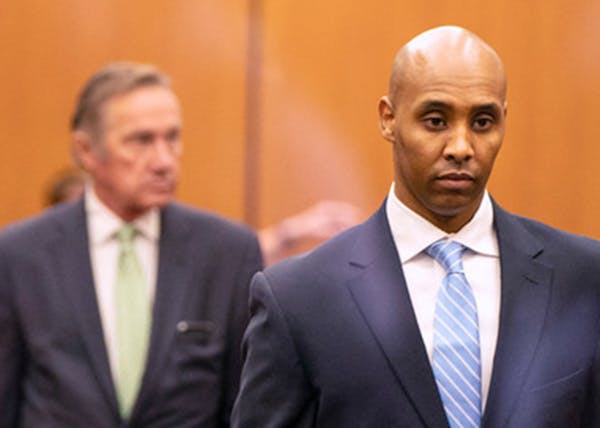Jurors deliberating the fate of a former Minneapolis police officer charged with fatally shooting Justine Ruszczyk Damond are debating two versions of the 2017 killing that reverberated around the world: An officer who acted recklessly when he fired at a woman who had called 911, and one who used his training to stop a possible threat to himself and his partner.
The prosecution and defense delivered heated closing arguments Monday before the jury of two women and 10 men received the case against Mohamed Noor about 2:15 p.m. Jurors, at least six of whom appear to be people of color, will be sequestered while they weigh the charges against Noor — second-degree murder, third-degree murder and second-degree manslaughter. They deliberated into the evening and are expected to resume Tuesday morning.
"This case has tragedy compounded on top of tragedy," Assistant Hennepin County Attorney Amy Sweasy said in her closing arguments. "[Damond is] gone because she was tragically and violently gunned down by a police officer she called for help."
Defense attorney Thomas Plunkett slammed his hand on a lectern at the start of his closing argument, dramatically re-enacting the moment he said Damond slapped Noor's squad car, startling him and his partner, Matthew Harrity. Damond appeared at Harrity's driver's side window and raised her right arm, Plunkett said, prompting Noor to shoot.
"If there had been a gun in that hand, Mr. Noor would be a hero … instead we have a tragedy," Plunkett said. "But what we don't have is a crime."
The attorneys' final appeal to jurors came after four weeks of trial, three of them with testimony. Approximately 61 witnesses were called, and evidence ranged from fingerprint analysis to graphic police body camera videos showing Damond gasping for air in the final moments of her life.
Noor and Harrity were responding to Damond's 911 call about a possible sexual assault in the alley behind her south Minneapolis home on July 15, 2017. Noor and Harrity both testified that a loud sound on their squad startled them, and that Noor fired from the passenger seat through Harrity's open driver's side window about 11:40 p.m.
Once jurors were dismissed for deliberations, Hennepin County District Judge Kathryn Quaintance addressed Damond's and Noor's families from the bench, acknowledging their pain. She thanked them for their "dignity and grace" through the "complicated circumstances" of the trial and its "very, very horrific evidence."
At trial, the prosecution meticulously documented alleged gaps in the police and state investigation of the shooting. While Sweasy told jurors Monday that the information gives them context to weigh all evidence and to judge witness credibility, Plunkett later attacked the strategy as one filled with "red herrings" and "sideshows" aimed at distracting them.
Early in its case prosecutors called officers, a firefighter and paramedics who rushed to the scene immediately after the shooting. Many of them testified that they were confused about what had occurred, and were not fully informed of the circumstances at the scene.
"It shows you that from the beginning, from the very beginning … nobody could understand why this happened," Sweasy said.
Despite the prosecution's overwhelming emphasis on alleged missteps by Minneapolis police and the Minnesota Bureau of Criminal Apprehension, which investigated the killing, Sweasy told jurors the case was about Noor's actions.
She attacked Noor's credibility, noting that while he said he threw his left arm over Harrity before rising up out of his seat to fire at Damond, Harrity never mentioned those details in his testimony. Noor also testified that upon hearing the loud noise, Harrity yelled out, struggled to unholster his gun and looked at him with fear in his eyes. Harrity did not testify that he struggled to unholster his gun or that he turned to look at Noor, Sweasy said.
"The defendant's story evolved and changed … in the two days you watched him on the stand," she said. "You should put great stock in the fact that [Harrity] did not act on" his fear and did not shoot Damond.
The defense's case leaned heavily on the belief that officers are trained to protect their partners, and that Noor had to act in a split-second or risk being killed had Damond been ambushing him and Harrity.
"It's the perfect storm," Plunkett said of the events that night. "We're not here to Monday-morning quarterback or use 20/20 hindsight."
The trial had "a lot of testimony but not necessarily a lot of evidence," he added.
Plunkett revisited Noor's training and his testimony about the last week of his cadet training — "Officer Survival Week" — in which officers are trained to respond to possible threats.
"Officers are trained to trust their partner," Plunkett said. "The key takeaway is saving your partner's life and in a safe manner."
Plunkett raised questions about Damond's actions that night — her decision to apparently walk down an alley "where she thought a predator was lurking" using what he described as "grace and stealth" she developed as a student of yoga, kickboxing and barre. His remarks caused Damond's father, John Ruszczyk, to throw his head back and shake it back and forth.
Plunkett also turned the prosecution's criticism of the investigation around and used it against the state's case.
"This is the state's investigation," Plunkett said. "If it's a bad investigation, then you have reasonable doubt. You can't blame [Noor] for it, and you can't hold a bad investigation against Mr. Noor."
"Mr. Noor made an objectively reasonable decision. It was just the wrong result."
Sweasy challenged Plunkett's characterization of Damond's actions in her rebuttal closing argument.
"This idea that she is somehow at fault … it's just more attempts to put the focus on her and what they think she did wrong instead of what [Noor] did wrong," Sweasy said. "He knew exactly what he was doing. He pointed, he aimed and he killed her."
Chao Xiong • 612-673-4391 Twitter:@ChaoStrib
Libor Jany • 612-673-4064 Twitter:@StribJany

Minneapolis education support workers authorize strike
Officials ID 14-year-old shot and killed while in SUV at northeast Mpls. gas station
Minnesota Republican congressional candidates seek endorsements at Saturday conventions

'No Mow May' eases to 'Less Mow May' in some Twin Cities suburbs

